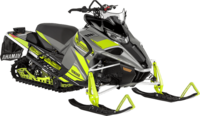|
Description
|
Conquer Snow
Winter can take on many forms, but one thing that will always remain consistent is the Sidewinder X-TX SE 137's ability to conquer snow. Ensure you can get where you want to go with the power produced by the Genesis 998T engine and YRSC high performance clutch. Take back your winter!
|
|

998 Yamaha Genesis Turbo Engine
-
Industry's highest horsepower
-
Designed around a premium turbo unit to produce uncompromised performance and reliability
-
Yamaha engineered for no turbo lag
|
|

YSRC High Performance Clutch System
-
Specifically designed for durable, cool operation
-
Faster backshift
-
Wider operation ratio
|
|

Dual Shock SR 137 Rear Suspension
-
Offers premium ride comfort with additional bump bridgin, flotation and traction
-
Coupled suspension that utilizes a unique sluding front arm mount
-
Reduced ski-lift during acceleration
|
|
Top Features
|
|
|
-
998 Genesis Turbo Engine
-
The turbo boosted, one liter triple is unmatched when it comes to delivering incredible power with the refinement and quality you have come to expect from a Yamaha. Designed around a premium turbo unit, every engine component from intake to exhaust, is dedicated to producing uncompromised performance. In only its second year in production the Yamaha turbo has earned the respect and reputation befitting the industries highest achiever. Truly this is the potent venom of a Sidewinders bite.
-
YSRC High Performance Clutch System
-
The YSRC primary and roller secondary clutches were specifically designed for durable, cool operation. They harness and transfer the massive torque produced by the Genesis Turbo, efficiently to the track while minimizing drive belt wear. The primary shifts out aggressively to use all the power on tap while the roller secondary is quick to back-shift and provides additional ratio through its oversize sheaves to keep accelerating long after the others have signed off.
-
Dual Shock SR 137 Rear Suspension
-
The Dual Shock SR 137 rear suspension is the cumulative result of years of punishment and development in snocross and cross-country competition. This long travel suspension offers premium ride comfort with additional bump bridging capabilities, floatation and traction thanks to its stretched length. The SR 137 is a "coupled" suspension that utilizes a unique "sliding" front arm mount. With up to half-inch of movement at the front arm "slot", the system allows the SR 137 to deliver controlled (reduced) ski-lift during acceleration while still retaining front arm bump compliance.
-
BackCountry X Track
-
The 1.75 inch lug BackCountry track is proven - dependable. When you want to hit the trail without worry about speed affecting track durability and still have the bite to dive confidently into the deep stuff, there is no better choice. The 137 inch version provides ample traction on soft, loose trails and still handles like a champ when they tighten up.
-
EBRS Engine Braking Control
-
The effect of 4-stroke 'engine braking' when the throttle valves are closed has a significant impact on handling and ride character. Yamaha developed a special system which employs the ISC (idle speed control) circuit and ECU map using throttle valve movement and RPM information to reduce negative intake pressure during deceleration.
|
|
Performance
|
|
|
-
High Tech Turbo
-
The Nickel alloy turbine body is extremely strong and precise, able to withstand highly elevated temperatures. Supported by premium, ceramic ball bearings, the Inconel turbine blade assembly is very light and strong. This yields a low moment of inertia for lightning quick response to exhaust gas input. Triple throttle bodies are used exclusively to further enhance the quick delivery of compressed air from the impeller to intake valves.
-
Mitsubishi Electronic Control Unit
-
The Yamaha-developed Mitsubishi ECU uses a series of 9 sensors to gather running condition data which it computes using a predetermined memory 'map'. It then adjusts ignition timing, fuel delivery, manifold air-pressure and turbo boost pressure to produce maximum performance under any condition - reliably.
-
Triple Throttle Body Induction
-
Yamaha wanted an engine that's exceptionally quick to respond with little or no 'lag' as found in a conventional turbo. One of the ways they achieved their goal was to develop an intake system using three separate throttle bodies positioned very close to the intake valves. Instead of just one feeding long intake tubes ? something that is not seen in any other production turbo on the planet. And another first for Yamaha with the Genesis turbo.
-
Electronic Air Bypass Valve (APV)
-
Unlike conventional turbo 'blow-off' valves, the Yamaha ABV redirects air pressure back into the intake side of the compressor to prevent surge and help maintain impeller speed, always at the ready for the next acceleration with seamless power delivery.
-
Liquid Cooled Turbo Body
-
Engine coolant is circulated through the turbocharger to control both underhood temperature and help cool the intake charge. Upon engine shut down, the convection energy produced by super-heated coolant at the turbo head keeps it circulating without the coolant pump in operation. This eliminates the need for an engine cool down cycle while maintaining high durability in the turbo components.
|
|
Handling
|
|
|
-
QS3 Shock Package
-
The front suspension features FOX® QS3 gas shocks with 3-way damping adjusters and pre-load adjustable coil-over springs. The front skid frame arm is controlled by a coil-over HPG 1.5 and the rear arm ios fitted with another premium QS3 damping adjustable shock absorber.
-
SRV Front suspension
-
The SRV front suspension geometry is aimed at managing spindle camber, resulting in minimized bump-steer and maximized cornering bite giving rider confidence in varying trail conditions. The A-arms are mounted at a 30-degree angle from the sled's centerline to efficiently dissipate impact force throughout the entire chassis. Likewise, the front shocks mount directly to the leading spar so that trail forces are routed to the strongest part of the chassis. Wide a-arm spacing minimizes flex and stress in the front suspension system, which means consistent and confident corner handling.
-
Lightweight, Rigid SRV Chassis
-
The SRV chassis combines a load-bearing triangulated structure with lightweight aluminum construction to create a neutrally balanced sled that's centered on the rider. The pyramidal upper frame creates chassis strength without excessive weight.
-
Gen3 Tuner Skis
-
The latest version of the Yamaha Tuner Ski is lightweight and designed for precise handling response. A wide selection of carbides can be combined to dial the Tuner to fit any riding style. Replaceable ski tips are available in multiple colors for additional customization.
-
Over-the-engine steering
-
The straight steering post on the Sidewinder is configured over the engine. It connects to a single bell crank for simplicity and light weight. The design also minimizes free-play in the steering system and delivers a tight turning radius.
|
|
COMFORT
|
|
|
-
Contoured Mountain Seat
-
Lightweight, with a tall and narrow profile, the M-TX mountain seat is both shorter and more tapered towards the front than our standard trail seat. This allows for easier rider transitions from side-to-side, and improved stand-up ergonomics.
-
Tapered tunnel design
-
The Sidewinder's light weight, two-piece, tapered tunnel gives you strength for the long haul and a tapered "fit" for enhanced leg comfort and overall ride positioning. The reinforced running boards are punched with aggressive boot hold serrations and offers excellent snow evacuation to keep your feet planted where you want them.
-
Digital Gauge
-
Full-featured and easy to read, the digital gauge displays critical information in a glance including speed, fuel level, trip mileage, tach and more. We even included a clock so you can watch the time fly.
-
Push Button Reverse
-
Convenient handlebar positioning makes shifting to and from reverse easy with just the push of your thumb. A servo motor shifts the drivetrain into reverse simply and consistently. An audible warning beeper reminds you when you are still in reverse.
-
Standard Electric Start
-
Yamaha's electric starter system allows you to fire up your Sidewinder with the turn of a key. There is no pulling on a nylon cord to get this high-tech engine growling! And you don't pay more - Electric start is a standard feature on all of Yamaha's 4-stroke machines.
|
|
|





